About
Eduino is an educational project run at the University of Edinburgh to teach the basics of electronics and Arduino. The project provides funding and expertise for 20 students, from any degree program, to learn Arduino and apply it in a creative or academic project. The group meets in a fortnightly workshop that teaches the fundamentals of Arduino and provides a collaborative space for members to work on their own Arduino projects.
Arduino is an open-source electronics platform that provides an accessible and fun way to learn about microcontroller (i.e. computer chip) programming. The projects that can be built with Arduino are endless, from designing scientific equipment to making musical instruments or building robots to creating dynamic art installations.
Check out what we have been up to on the blog, and see the list of members and their projects below!
Participants
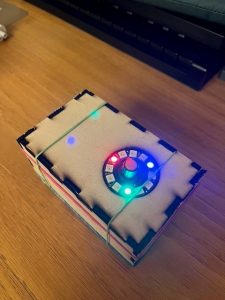
As a student in Music Technology, I wanted to create my own music instrument,
which plays the way I want it to. Eduino helped me realise the potential of
Arduino in the realisation of this project, so I got to work!
I built a circuit that ties an Arduino Nano 33 IoT to a rotary encoder,
a NeoPixel ring by AdaFruit, a piezo sensor and an external battery.
After soldering came putting the box together, for which I've used plywood and
custom 3D printed parts.
The box connects via BlueTooth to my laptop, running MaxMSP 8. The software
decodes the messages sent by the box into messages my digital audio
workstation understands, where it triggers sounds at corresponding pitches.
The music it plays is chord based: there is one chord for each of the 8
corners of the box which plays when that corresponding corner is at the top.
The box senses motion and responds accordingly. The knob acts as a sound
selector: with each turn, it changes a certain sound, with the NeoPixel ring
being a visual indication of that. Pressing down on the knob recalibrates the
inner tempo of chord changes and tapping the outlined circle at the bottom of
the box triggers a bass note.
The beauty of it all is that while the circuit is fixed, the software is
easily editable and all of the inputs can be changed in a myriad of ways.
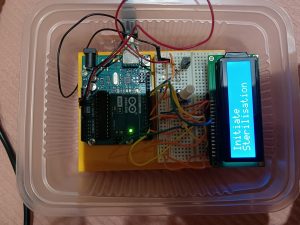
My name is Angela, I'm a third year Biological Sciences student and my project is a mini UV steriliser. With Arduino, I came into contact with a wide variety of IOT projects and got to experiment with electronic components I had never seen before, with my favourite being a piezo which was used in building a light theremin. For my project, I wanted to make something that I would use myself, and I turned to the idea of making a device in which I could sterilise small objects like phones, wallets, and keys, something that can come in handy during the pandemic. While the sterilisation itself is done with a timed light switch, I am also planning to use a Bluetooth component to activate the light from a distance. Safety is paramount – I'm currently just using LEDs and an LCD to test my coding!
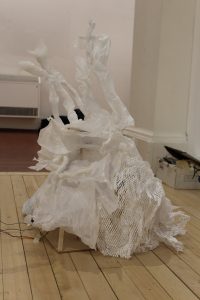
Hi, I’m Claire and I’m a 3rd year BA Intermedia student at the School of Art.
I joined the Eduino project to develop my very limited Arduino skills – I’d been trying to teach myself as part of my art practice but needed more support. My art practice centres around pushing on traditional art gallery narratives of distant and controlled viewership of objects, and instead trying to encourage interaction between human viewers and non-human objects, while exploring ideas around non-human sentience. I am working towards creating sculptures that move, both when they react to someone being near and when ‘unactivated’ in a constant state of ‘living’.
Learning Arduino has let me be playful with motors and making things move – the question I always ask myself is: ‘what if it moved?’ I find this intrigues my audiences as well as keeping my research exciting. I’m currently trying to make an old phone ‘breathe’, but my aims are to make sculptural installations that surround the space.
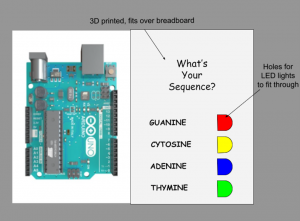
My name is Emma and I am a third-year studying Molecular Genetics. I have enjoyed learning Arduino because it is great exposure to an interactive and comprehensible programming platform. It has been great to slowly work towards understanding the code and then coming up with a project idea I am passionate about. My idea is to use four different coloured LED lights to represent each of the four genetic bases. The user will input a genetic sequence and the Arduino board with a 3D printed cover will light up and visualise the sequence. It is designed to reflect the view of the flow cell in Next-Generation Sequencing. I hope it can be used in a science classroom setting to get students excited about Genetics.

I'm Ezra, a third year PhD student in the School of Chemistry. I am running the Eduino group alongside Tasnim. I decided to apply for a grant to run a university wide Arduino learning group after taking part in an Arduino group for Chemistry postgraduates the previous year. Before this, I had never heard of Arduino and had little knowledge of electronics. After a few weeks I was hooked and thrilled with the creative potential of Arduino; it seemed to me that Arduino would have uses in every discipline, not just science. One of the highlights of Eduino has been seeing the diverse range of projects in which students have applied Arduino.
For my project I have created a wireless MIDI controller to go on the pickguard of an acoustic guitar. I perform and record fingerstyle guitar music and wanted a way to control a software synthesizer during live performances. This would allow me to perform more complex arrangements and diversify my sound.
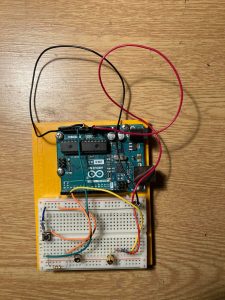
Hi, I'm Ioana, a 3rd year Chemistry Student and I have joined this group in order to learn Arduino, develop some of my C++ coding skills and learn about the interdisciplinary use of electronics. As I was interested in using Arduino in order to construct easy to use and energy efficient laboratory instruments, I have chosen to construct a single-wavelength UV/Vis spectrometer. Such an instrument would be incredibly useful for the study of microbial activity and using a LED that emits light at 490 nm, it can be used for the classical FDA assay. I also aim to compare the performance of this instrument with that of one commonly used in a research laboratory.

Hi, I’m Lisa, a second-year Intermedia Art student. I am a beginner at working with electronics, but Eduino has helped me gain practical skills that I have always wanted to explore but never knew how.
After seeing intriguing artworks with mechanical functions, such as a grabbable sculpture that vibrates at the speed of an audience’s heart rate, I have become interested in including electronics to create interactive and engaging works of art. Eduino is the first step to achieving making them and developing my overall art practice.
Having been inspired by the idea of subjective time, in the project, I am trying to make a personalized clock. This clock displays its second hand moving at a certain speed that is worked out based on the individual’s age, heart rate, mood, schedule, etc of the moment they stand in front of the clock. How fast/slow do you think your time passes compared to others?
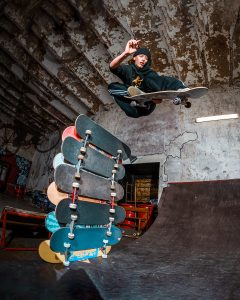
Hi, my name is Luc! I am a second-year undergraduate chemistry student with a growing interest in environmental chemistry. In my free time, I enjoy skateboarding, which is what my Arduino project originated from. The idea was to create a portable contraption which would measure the height of an ollie. This would be done using a microphone input, as the board makes a sound as it leaves the ground and when it comes back into contact with it. The time spent in the air could then be converted to a height and in turn displayed on an LCD screen! Unfortunately, I did not get very far into my project due to other reasons, so if anyone is keen to take over this project, feel free too! Eduino is a super fun activity to have going, as you meet really cool people and learn valuable skills at the same time.

I'm Martina, a second year PhD student working on improving the growth and bioproducts production of microalgae in the lab. Before joining the Eduino group, I had no experience with working with Arduino and very little knowledge of electronics. Learning Arduino pushed me to step out of my comfort zone, learn something new and understand a little bit better how all the electronics around us actually functions! What really surprised me was the range of possibilities and projects that you can do with Arduino, and it made me question how could I implement this for my research?
Since a lot of the lab equipment is often expensive and therefore inaccessible for most researchers, I wanted to use Arduino to assemble a lower-cost device that can be used to measure oxygenation in any cultures or liquid systems. This would allow me to control and optimize my current microalgal cultivation system in the lab. I am hoping to develop my experimental setup further by implementing Arduino with different components.
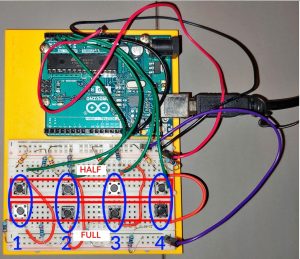
My name is Mick Zijdel, and I am a third year student in Acoustics and Music Technology. I am incredibly interested in how technology can be used to create new instruments, so for my Arduino project, I have made an electronic 4-hole Ocarina.
The instrument can be played by holding different combinations of buttons. The button combination is send to a laptop running Max MSP, which generates the sound. Making it electronic allows for a much wider range of sound, and using sensors on the Arduino, such as a motion sensor, to control the parameters of the sound allows for a lot of flexibility. I have really enjoyed learning more about Arduino and how I can use microcontrollers for real-time physical interaction with an instrument.
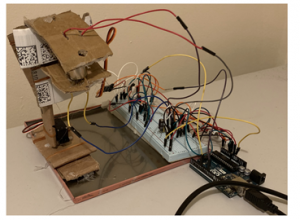
Hi, my name is Sivarajan Sivakumar and I am a third year Chemical Physics student. I have always wanted to work with electronics but I never knew where and how to start. This program gave me a great opportunity to learn by doing mini projects from the Arduino Handbook. The bi-weekly sessions were a great way to discuss project ideas with others in the program and keep up to date with the material needed to be covered in the handbook. Towards the end of the program, I decided to create a mechanical arm with an acoustic levitation device attached to its end for my project. The inspiration for the project came from the sonic tractor beams in Star Wars. Servo motors were used for the mechanical arms and two transmitters removed from ultrasonic sensors were used to hold small objects in place. Overall, the experience was enjoyable and rewarding.

Hi, I’m Tas and I’m a 3rd year Ecology student at the School Biological Sciences. I helped Ezra set up our group during its early stages. I also created the Eduino logo.
Arduino has been such a joy to learn as it allowed me to experience the satisfaction of completing very cool small projects and find C++ programming much less intimidating. It also made me understand better how some electronic components and circuit boards work.
For my project, I’m making a productivity gadget based on the Pomodoro method as a motivational and efficient way of tracking an individual’s working time. It was especially helpful to me and my friends during the COVID-19 lockdowns. As a creative twist, I plan to design the final product as a pomegranate-shaped device (despite pomodoro meaning tomato in Italian) as inspired by my study group who used the pomodoro method and jokingly called ourselves the Pomogrannies.

Hi, I am Yuan, a third year PhD student studying Chemistry. I am always keen to try new things, and part of my PhD project involving equipment development, which gave me the chance to know about Arduino as a cool and powerful tool. It is my pleasure to be part of the Eduino team, in which I start to learn more about Arduino, and to develop my own project, an automatic NMR tube washer.
NMR is a common technique used in chemistry lab, and NMR tube has a size similar to a pencil, but narrower. It is a pain to clean the tube by brush and the commercial washer is expensive (> £100) and also requires manual operation. It would be nice if a machine can wash the tubes instead of me — that’s the origin of this project. By using vacuum, solvents are pushed from the solvent tank, through the whole NMR tube, and into the flask via the yellow tubing. The on and off of the vacuum is controlled by a solenoid valve, and different solvents can be selected via servo motor on the top. I am currently working on it and hopefully, it will be able to run different solvents with varied washing time and cycles, and fully automatic!
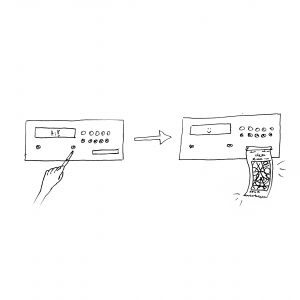
Hello, my name is Zita. I'm a 2nd year Product Design student who loves everything which involves crafting. That's the main reason I decided to join the amazing team of Eduino. It's been great to explore the endless opportunities that are possible with Arduino and to learn how to make it work with code.
The project that I'm currently working on is a small object that you can interact with via buttons. It guides you through the selection process where you can select primitive shapes from 1 to 5. When the selection is done, the object prints out your very unique randomly generated picture on a receipt, featuring your chosen shapes.
What is the most interesting to me in carrying out our project from the beginning to the end is that we have control over every aspect of it, starting with designing, making the electronics, coding, and finishing with 3d printing.
This project was supported by alumni and friends of the University of Edinburgh through the Student Experience Grants scheme. We would also like to thank the staff at uCreate Studio for providing access to expertise, equipment and workshop space. If you have any questions about the project, please contact ezra.kitson@ed.ac.uk.